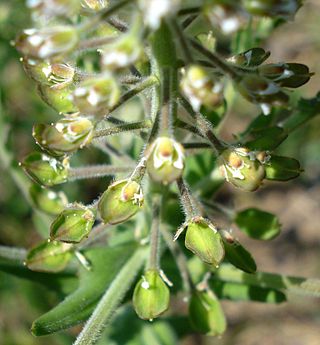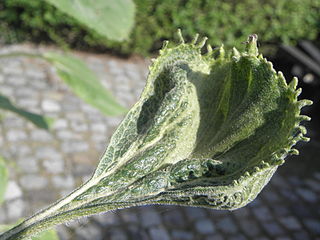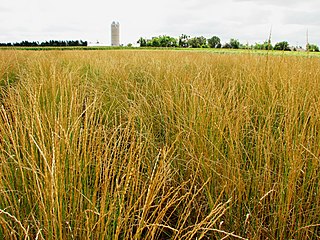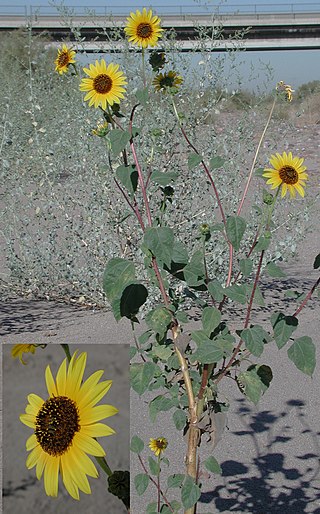
The common sunflower is a large annual forb of the genus Helianthus. It is commonly grown as a crop for its edible oily seeds. Apart from cooking oil production, it is also used as livestock forage, as bird food, in some industrial applications, and as an ornamental in domestic gardens. Wild H. annuus is a widely branched annual plant with many flower heads. The domestic sunflower, however, often possesses only a single large inflorescence atop an unbranched stem.

The sunflower seed is the seed of the sunflower. There are three types of commonly used sunflower seeds: linoleic, high oleic, and sunflower oil seeds. Each variety has its own unique levels of monounsaturated, saturated, and polyunsaturated fats. The information in this article refers mainly to the linoleic variety.

Rapeseed, also known as rape, or oilseed rape, is a bright-yellow flowering member of the family Brassicaceae, cultivated mainly for its oil-rich seed, which naturally contains appreciable amounts of erucic acid. The term "canola" denotes a group of rapeseed cultivars that were bred to have very low levels of erucic acid and which are especially prized for use as human and animal food. Rapeseed is the third-largest source of vegetable oil and the second-largest source of protein meal in the world.

The Jerusalem artichoke, also called sunroot, sunchoke, wild sunflower, topinambur, or earth apple, is a species of sunflower native to central North America. It is cultivated widely across the temperate zone for its tuber, which is used as a root vegetable.

Helianthus is a genus comprising about 70 species of annual and perennial flowering plants in the daisy family Asteraceae commonly known as sunflowers. Except for three South American species, the species of Helianthus are native to North America and Central America. The best-known species is the common sunflower. This and other species, notably Jerusalem artichoke, are cultivated in temperate regions and some tropical regions, as food crops for humans, cattle, and poultry, and as ornamental plants. The species H. annuus typically grows during the summer and into early fall, with the peak growth season being mid-summer.

Citrullus colocynthis, with many common names including Abu Jahl's melon,colocynth, bitter apple, bitter cucumber, egusi, vine of Sodom, or wild gourd, is a desert viny plant native to the Mediterranean Basin and Asia, especially Turkey, and Nubia.

Lepidium campestre, the field pepperwort or field pepperweed or field cress, is usually a biennial with some form of annual plant in the Brassicaceae or mustard family, native to Europe, but commonly found in North America as an invasive weed. The most notable characteristic of field pepperweed is the raceme of flowers which forks off of the stem. These racemes are made up of first small white flowers and later green, flat and oval seedpods each about 6 mm long and 4 mm wide. Each seedpod contains two brown, 2.5 mm long seeds.

Plasmopara halstedii is a plant pathogen infecting sunflowers. The species is one of many pathogens commonly referred to as downy mildew. P. halstedii originated in North America.
Phoma macdonaldii is a plant pathogenic fungus that is a major causal force for the disease Phoma Black Stem.
Alternaria helianthi is a fungal plant pathogen causing a disease in sunflowers known as Alternaria blight of sunflower.

Helianthus maximiliani is a North American species of sunflower known by the common name Maximilian sunflower.

Helianthus schweinitzii is a perennial wildflower endemic to the Piedmont physiographic province of North Carolina and South Carolina. Its common name is Schweinitz's sunflower. It is a member of the sunflower family (Asteraceae). It is one of the rarest species of sunflower in the United States. It is common along utility and highway rights-of-way in North Carolina and South Carolina. There are only about 90 known populations, many containing less than 40 plants each. The U.S. Fish and Wildlife Service listed Schweinitz's sunflower as an endangered species on May 7, 1991.

Thinopyrum intermedium, known commonly as intermediate wheatgrass, is a sod-forming perennial grass in the Triticeae tribe of Pooideae native to Europe and Western Asia. It is part of a group of plants commonly called wheatgrasses because of the similarity of their seed heads or ears to common wheat. However, wheatgrasses generally are perennial, while wheat is an annual. It has gained the Royal Horticultural Society's Award of Garden Merit as an ornamental.
Phoebanthus, called false sunflower, is a genus of North American plants in the tribe Heliantheae within the family Asteraceae.

Perennial rice are varieties of long-lived rice that are capable of regrowing season after season without reseeding; they are being developed by plant geneticists at several institutions. Although these varieties are genetically distinct and will be adapted for different climates and cropping systems, their lifespan is so different from other kinds of rice that they are collectively called perennial rice. Perennial rice—like many other perennial plants—can spread by horizontal stems below or just above the surface of the soil but they also reproduce sexually by producing flowers, pollen and seeds. As with any other grain crop, it is the seeds that are harvested and eaten by humans.

A perennial grain is a grain crop that lives and remains productive for two or more years, rather than growing for only one season before harvest, like most grains and annual crops. While many fruit, nut and forage crops are long-lived perennial plants, all major grain crops presently used in large-scale agriculture are annuals or short-lived perennials grown as annuals. Scientists from several nations have argued that perennial versions of today's grain crops could be developed and that these perennial grains could make grain agriculture more sustainable.
Perennial crops are crops that – unlike annual crops – don't need to be replanted each year. After harvest, they automatically grow back. Many fruit and nut crops are naturally perennial, however there is also a growing movement to create perennial alternatives to annual crops. From the 1920s to the 1950s, researchers in the former Soviet Union attempted to perennialize annual wheats by crossing them with perennial relatives such as intermediate wheatgrass. Interest waned when the crosses repeatedly resulted in sterile offspring, and seed yield decreased significantly. The next major time the project of perennializing grain was picked up was a wheat hybrid developed by the Montana Agricultural Experiment Station in 1986, which the Rodale Institute field tested. For example, The Land Institute has bred a perennial wheat crop known as Kernza. By eliminating or greatly reducing the need for tillage, perennial cropping can reduce topsoil losses due to erosion, increase biological carbon sequestration, and greatly reduce waterway pollution through agricultural runoff due to less nitrogen input.

Helianthus anomalus, the western sunflower, is a species of plants in the family Asteraceae, found in the southwestern United States.

Silphium integrifolium is a species of flowering plant in the family Asteraceae. Its common names include rosinweed, whole-leaf rosinweed, entire-leaf rosinweed, prairie rosinweed, and silflower. It is native to eastern North America, including Ontario in Canada and the eastern and central United States as far west as New Mexico.
Hybridization, when new offspring arise from crosses between individuals of the same or different species, results in the assemblage of diverse genetic material and can act as a stimulus for evolution. Hybrid species are often more vigorous and genetically differed than their ancestors. There are primarily two different forms of hybridization: natural hybridization in an uncontrolled environment, whereas artificial hybridization occurs primarily for the agricultural purposes.





















